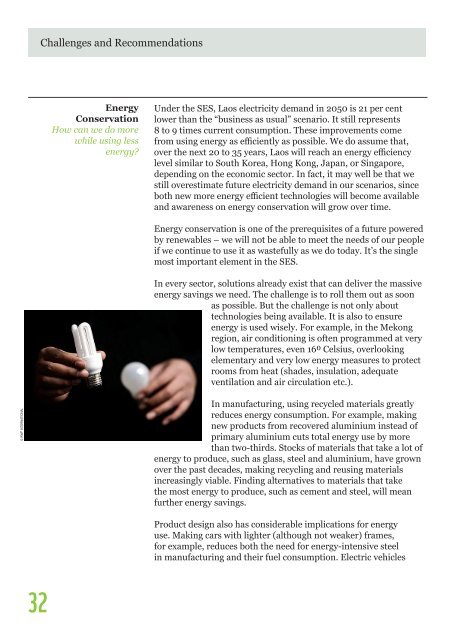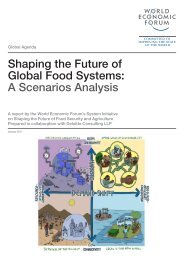Vision 2050
wwf_greater_mekong_power_sector_vision_2050
wwf_greater_mekong_power_sector_vision_2050
Create successful ePaper yourself
Turn your PDF publications into a flip-book with our unique Google optimized e-Paper software.
Challenges and Recommendations<br />
Energy<br />
Conservation<br />
How can we do more<br />
while using less<br />
energy?<br />
Under the SES, Laos electricity demand in <strong>2050</strong> is 21 per cent<br />
lower than the “business as usual” scenario. It still represents<br />
8 to 9 times current consumption. These improvements come<br />
from using energy as efficiently as possible. We do assume that,<br />
over the next 20 to 35 years, Laos will reach an energy efficiency<br />
level similar to South Korea, Hong Kong, Japan, or Singapore,<br />
depending on the economic sector. In fact, it may well be that we<br />
still overestimate future electricity demand in our scenarios, since<br />
both new more energy efficient technologies will become available<br />
and awareness on energy conservation will grow over time.<br />
Energy conservation is one of the prerequisites of a future powered<br />
by renewables – we will not be able to meet the needs of our people<br />
if we continue to use it as wastefully as we do today. It’s the single<br />
most important element in the SES.<br />
In every sector, solutions already exist that can deliver the massive<br />
energy savings we need. The challenge is to roll them out as soon<br />
as possible. But the challenge is not only about<br />
technologies being available. It is also to ensure<br />
energy is used wisely. For example, in the Mekong<br />
region, air conditioning is often programmed at very<br />
low temperatures, even 16⁰ Celsius, overlooking<br />
elementary and very low energy measures to protect<br />
rooms from heat (shades, insulation, adequate<br />
ventilation and air circulation etc.).<br />
© WWF INTERNATIONAL<br />
In manufacturing, using recycled materials greatly<br />
reduces energy consumption. For example, making<br />
new products from recovered aluminium instead of<br />
primary aluminium cuts total energy use by more<br />
than two-thirds. Stocks of materials that take a lot of<br />
energy to produce, such as glass, steel and aluminium, have grown<br />
over the past decades, making recycling and reusing materials<br />
increasingly viable. Finding alternatives to materials that take<br />
the most energy to produce, such as cement and steel, will mean<br />
further energy savings.<br />
Product design also has considerable implications for energy<br />
use. Making cars with lighter (although not weaker) frames,<br />
for example, reduces both the need for energy-intensive steel<br />
in manufacturing and their fuel consumption. Electric vehicles<br />
32




